
Dic . 19, 2024 07:14 Back to list
Impact of White Spot Disease on Aquaculture Operations and Management Strategies
Understanding White Spot Disease A Threat to Aquaculture
White Spot Disease (WSD) has emerged as a significant threat in aquaculture, particularly affecting the shrimp farming industry. This highly contagious viral infection is caused by the White Spot Syndrome Virus (WSSV), which has devastating repercussions on marine life and the economies that depend on aquatic farming. Understanding the dynamics of WSD, its impact on the industry, and potential solutions is crucial for maintaining healthy aquatic ecosystems and the economic stability of regions reliant on shrimp farming.
The Nature of White Spot Disease
WSD is characterized by the appearance of white spots on the exoskeleton of infected shrimp. These spots are caused by the accumulation of white spot syndrome virus inside the tissues. The virus affects various shrimp species, including the highly farmed Litopenaeus vannamei (Pacific white shrimp) and Penaeus monodon (Giant tiger prawn). Infected shrimps exhibit a range of symptoms, including lethargy, loss of appetite, and accelerated mortality rates.
The transmission of WSSV is rapid, as the virus can spread through water, equipment, and even personnel. Environmental stressors, such as temperature fluctuations, poor water quality, and overcrowding, can exacerbate the spread of the virus. Once introduced into a shrimp farming facility, WSD can lead to catastrophic losses—morality rates can reach up to 100% in infected populations within days.
Economic Consequences
The economic implications of White Spot Disease are substantial. Shrimp farming is a vital economic activity in many countries, providing livelihoods for millions of people globally. In regions such as Southeast Asia and Latin America, where shrimp farming constitutes a significant portion of exports, outbreaks of WSD can cripple local economies. Farmers face not only the direct costs of loss of stocks but also the expenses associated with management interventions, biosecurity measures, and the need to restock healthy shrimp.
Market prices of shrimp typically increase during outbreaks due to supply shortages, but this temporary spike does little to compensate for the extensive losses incurred by farmers. Additionally, the risk of disease can lead to decreased investor confidence in the aquaculture sector, hampering growth and innovation.
Prevention and Control Measures
white spot disease factory

Efforts to control and prevent White Spot Disease focus on both biosecurity measures and sustainable farming practices. Biosecurity is critical in limiting the introduction and spread of WSSV. Enhanced practices include strict sanitation protocols for equipment, regular monitoring of shrimp health, and careful management of water quality.
Farmers are encouraged to implement disease management plans that include regular screening for WSSV, using polymerase chain reaction (PCR) tests to identify infected populations early. Moreover, proper stocking densities and minimizing stress conditions—such as overcrowding and abrupt changes in water temperature—can reduce susceptibility to infections.
Vaccination and breeding programs also hold promise for managing WSD. Research into developing shrimp lines with genetic resistance to WSSV is ongoing, and progress has been made in selective breeding practices that could lead to more resilient shrimp stocks.
Future Directions
The future of aquaculture in the face of White Spot Disease requires a collaborative approach involving farmers, researchers, and policymakers. Improved research into disease mechanics, monitoring technologies, and management practices will be essential for developing effective responses to viral outbreaks.
Furthermore, investment in environmental sustainability is vital. Ensuring that aquaculture practices do not compromise water quality or biodiversity will create a more resilient industry that can better withstand disease impacts.
Conclusion
White Spot Disease poses a significant challenge to the aquaculture sector, threatening not only shrimp populations but also the livelihoods dependent on them. As the industry evolves, proactive measures encompassing biosecurity, sustainable farming practices, and scientific research will be integral to mitigating the impact of WSD. By fostering a collaborative environment between all stakeholders involved in aquaculture, it is possible to navigate the complexities of shrimp farming while safeguarding both economic interests and aquatic life for future generations.
-
Cyanosis of the Skin Solutions Trusted Manufacturers & Suppliers
NewsMay.20,2025
-
Porcine Toxoplasmosis Kits Reliable Suppliers & Manufacturers
NewsMay.20,2025
-
Dermatitis Relief Creams & Ointments Trusted Manufacturer & Supplier
NewsMay.20,2025
-
Pleurisy Factory High-Quality Manufacturer & Supplier Solutions
NewsMay.19,2025
-
Premium Dexamethasone for Equine & Climbing Trusted Suppliers & Factory
NewsMay.19,2025
-
Sulfamono Methoxine Supplier High-Quality Veterinary Antibiotic
NewsMay.18,2025




